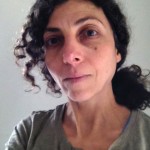
Marina Mangubi
Department of Art and Art History, The College of Wooster, Ohio, USA
mmangubi@wooster.edu
Biography
Marina Mangubi is an Associate Professor of Art the College of Wooster in Ohio. A painter, printmaker, and installation artist, Marina Mangubi holds an A.B. from the University of California, Berkeley, in Art and in Psychology (Neuroscience), and an M.F.A. from the University of Michigan. Her work has been exhibited in the United States and internationally, including Germany, Russia, Japan, Malaysia, Belarus, Uzbekistan, and Albania, and is in permanent collections of Portland Museum of Art in Maine, the Gilkey Center for Graphic Arts at the Portland Museum of Art in Oregon, and Kala Institute in Berkeley. Marina Mangubi has participated in numerous residencies and was the artist fellow at the Camargo Foundation in Cassis, France. Her projects have been profiled on national television in France and Russia.
Illustrated Talk
Neuroscience and the Printmaking Method
In his 1871 lecture “The Relation of Optics to Painting”, Hermann Helmholtz urged physiologists to look to artists, “whose observation of sensuous impression is particularly vivid and accurate, and whose memory for these images is particularly true”, and not to ignore “that which [artists] have found by innumerable experiments in most varied directions as regards, means and methods of representation”. The insight is even more astute in light of current neuroscience research.
Familiar to any printmaker from practice, the analytical process of deconstructing an image in terms of its formal features and reconstituting it via printmaking techniques in layered matrices may offer a useful metaphor for visual cognition, as multiple-stage abstraction accompanied by detail conservation is at the heart of both processes.
In Eight Board Feet, a series of drypoints and paintings, I have used printmaking for analyzing and permuting the image, and for melding observational and imaginary segments in a cohesive whole. I am not alone in this practice. For instance, Peter Doig’s vast painterly compositions are derived from photographic images, via the printmaking process.
As an artist with a neuroscience background, I have researched current literature on the mechanisms of visual processing, which occur subcortically and at higher cognitive centers, and hypothesizing how printmaking methods engage visual cognition and memory.
Worth noting is the finding by a cognitive psychologist Robert Solso that brains of artists, who were given a drawing task, exhibited greater propensity for structural mapping of familiar objects, whereas the brains of control subjects, asked to perform the same task, privileged naming and categorizing over analysis of forms.
While any attempt at inferring the complexity of artists’ thinking from reductionist experimental paradigms would be naïve, we may begin to consider ways in which the printmaking process affects coding and retrieval of information, both effortfully and intuitively
